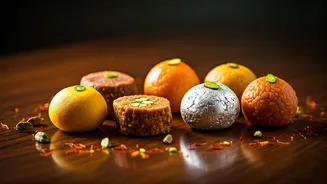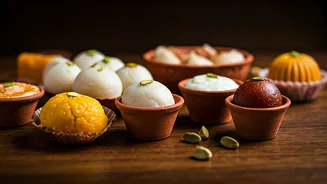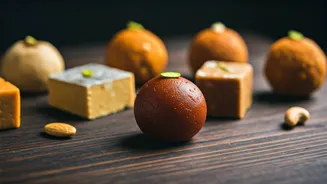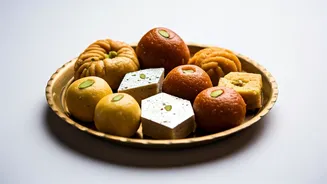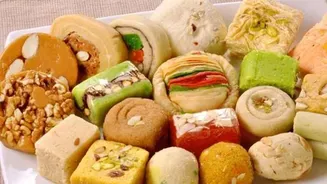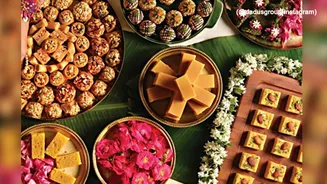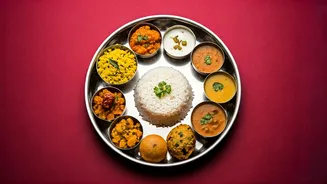Introduction to Diwali
Diwali, the festival of lights, is a time of immense joy, feasting, and the sharing of sweets. While many people turn to the usual options like gulab jamun
and barfi, India's culinary landscape is filled with a rich diversity of sweets, many of which remain relatively unknown. This article shifts the focus to discover these hidden gems – sweets that represent different regions and offer unique flavors. The goal is to encourage a more diverse and exciting Diwali celebration, filled with new tastes and experiences beyond the traditional staples. This exploration promises a delightful journey through the less-trodden paths of Indian confectionery, broadening the celebratory experience.
Gujarati Mohanthal
Mohanthal, a classic Gujarati sweet, boasts a rich, grainy texture and a melt-in-your-mouth experience. Made from gram flour (besan), ghee, sugar, and often flavored with cardamom and nuts, it offers a delightful mix of flavors and textures. The slow cooking process, which involves roasting the besan in ghee, is critical to achieving its unique texture and aroma. The preparation takes time and patience, but the resulting delicacy is well worth the effort. Mohanthal is a traditional sweet, often made during festivals and special occasions, showcasing the rich culinary traditions of Gujarat and embodying the spirit of celebration and togetherness. It's a sweet with a history, representing the deep-rooted cultural heritage of the region.
Karnataka's Mysore Pak
Mysore Pak, originating from the royal kitchens of Mysore, is another must-try sweet. This rich, melt-in-your-mouth confection is made with gram flour, ghee, and sugar. The ghee is the key ingredient, giving the sweet its characteristic porous texture and heavenly taste. The process involves slow cooking, carefully adding ghee to the mixture while stirring continuously to achieve the desired consistency. The result is a sweet that's both crumbly and rich, with a unique aroma. Often regarded as a symbol of Karnataka's culinary excellence, Mysore Pak is more than just a treat; it represents the state's rich heritage. Its popularity has spread beyond the region, delighting sweet lovers across India and the world.
Goan Bebinca
Bebinca, also known as the 'queen of Goan desserts', is a layered cake made with coconut milk, flour, sugar, and ghee. Each layer is baked individually, resulting in a distinct texture and appearance. This multi-layered structure is its defining characteristic, giving it a unique visual appeal alongside its delicious taste. Traditionally prepared during festive occasions, especially Christmas, Bebinca is a testament to the influence of Portuguese culinary heritage in Goa. The slow baking process and the layering require great skill and patience, making it a labor of love. It offers a unique combination of textures – a slightly chewy outer layer with soft, flavorful layers within, making it a truly exceptional dessert experience, reflecting the unique cultural blend of the region.
Andhra's Pootharekulu
Pootharekulu, or 'paper sweets', are a unique delicacy from Andhra Pradesh. These sweets are crafted from rice flour and sugar, meticulously formed into thin, delicate sheets, resembling paper. Often filled with dry fruits, jaggery, and ghee, they offer a delightful combination of textures. The process of making Pootharekulu is a testament to culinary skill, demanding precision and patience. These sweets are often prepared for festivals and celebrations, representing the artistic approach of Andhra Pradesh. The delicate appearance and exquisite taste make them a special treat that is both visually appealing and incredibly satisfying. The paper-thin sheets, filled with the richness of dry fruits and ghee, create a sweet that's light yet flavorful.
Assam's Pitha Varieties
Assam is renowned for its diverse range of Pithas – traditional rice cakes, which are often prepared during Bihu festivals. These come in various forms, including the Tekeli Pitha (steamed), Til Pitha (sesame-filled), and Ghila Pitha (fried). These rice-based treats are prepared with ingredients that vary from region to region, and from season to season, but the core essence is always preserved. These pithas represent the essence of Assamese cuisine, reflecting the local ingredients and cooking techniques. Pithas represent communal togetherness as communities come together to prepare and share these traditional sweets. Each variety brings a unique taste and texture to the table, showcasing the rich diversity of Assamese culinary heritage and the joy of festive celebrations.
Bihar's Khaja
Khaja, a traditional sweet from Bihar, is a deep-fried pastry with a flaky texture, often dipped in sugar syrup. The layers of the pastry are created through a meticulous process, resulting in a crispy and light sweet. The preparation requires a specific technique to achieve the desired flaky texture, making it a skill passed down through generations. Khaja is not only a sweet but also a symbol of Bihari culinary heritage, often enjoyed during festivals and special events. The delicate layers and the sweetness from the syrup create a delightful sensory experience. This sweet embodies the history of Bihar's rich culinary traditions and the joy of sharing food with loved ones.
